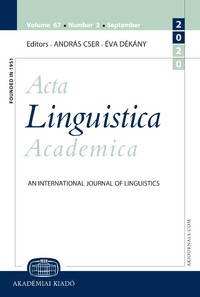The perception of voicing contrast in assimilation contexts in minimal pairs: evidence from Hungarian
The perception of voicing contrast in assimilation contexts in minimal pairs: evidence from Hungarian
Author(s): Zsuzsanna Bárkányi, Zoltán KissSubject(s): Finno-Ugrian studies
Published by: Akadémiai Kiadó
Keywords: regressive voicing assimilation; perception; neutralisation; compensation; Hungarian; minimal pairs
Summary/Abstract: It has been long acknowledged that the perception and production of speech is affected by the presence or absence of higher levels of linguistic information, too. The recoverability of meaning heavily relies on semantic context, similarly, the precision of articulation is inversely proportional to the presence of semantic information. The present study explores the recoverability of the voice feature of word-final alveolar fricatives in minimal pairs in Hungarian in phonetic contexts that trigger regressive voicing assimilation. Specifically, it aims to clarify whether the acoustic differences found in earlier studies are perceptually salient enough to distinguish underlying voicing in minimal pairs in semantically ambiguous contexts. For this reason, a perception study with the synthesised minimal pair mész–méz ‘whitewash–honey’ was carried out where the amount of voicing in the fricative, and the duration of the fricative and vowel were manipulated. The target words appeared in the following three phonetic contexts: before /p/, before /b/ and before the vowel /a/. Our results suggest that the observed acoustic differences in most of the cases remain below the perceptual threshold which means that phonological contrast is indeed neutralised before obstruents in Hungarian, and this may cause semantic ambiguity.
- Issue Year: 68/2021
- Issue No: 1-2
- Page Range: 207-229
- Page Count: 23
- Language: English

